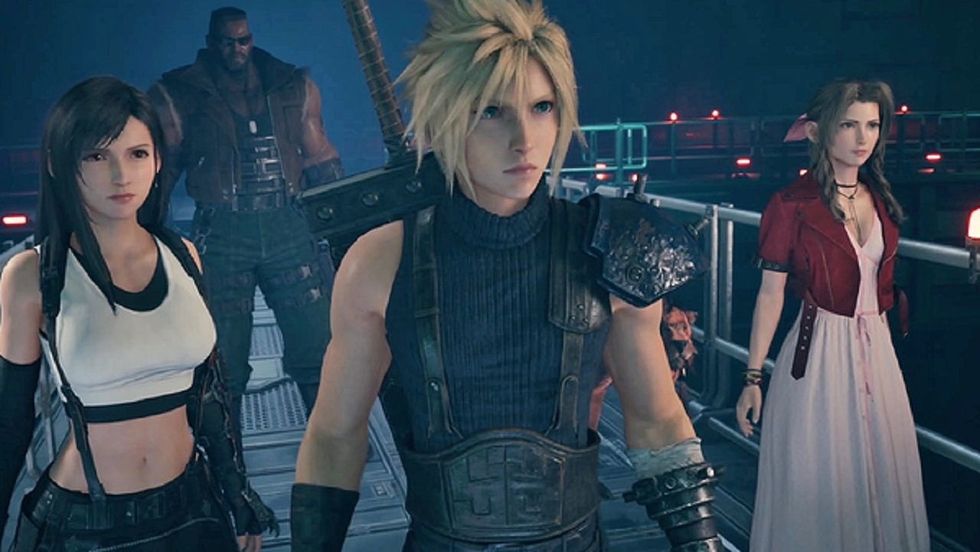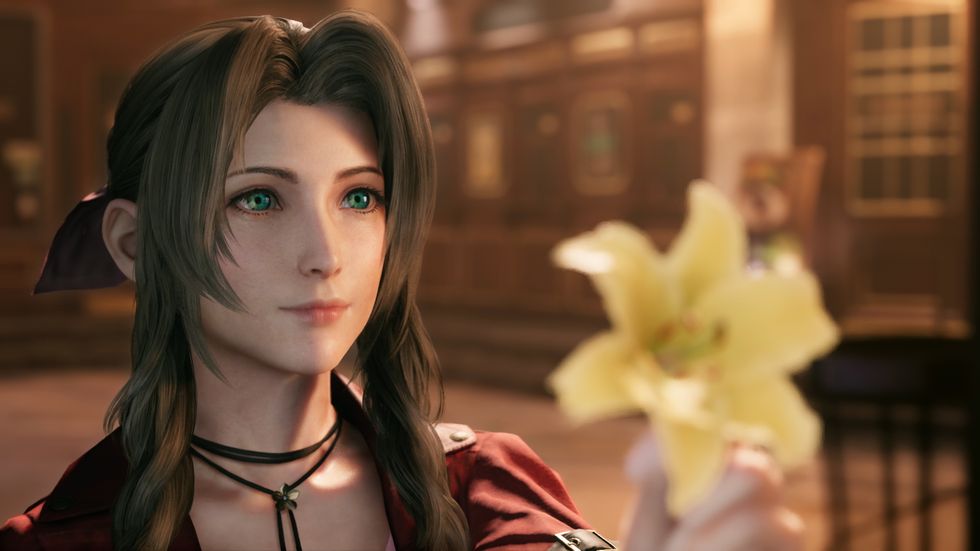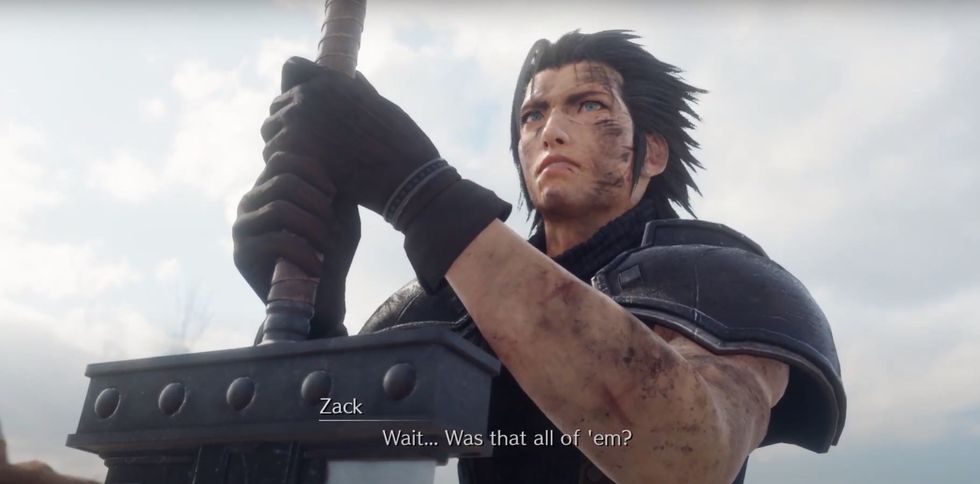
Square Enix
Between the constant revivals of classic franchises and the endless sequels to anything and everything we’ve ever loved, pop culture of the modern era reeks of soulless cash grabs perfumed in cheap nostalgia.
But amidst an endless sea of crap, Final Fantasy VII: Remake is a different beast entirely. Despite Final Fantasy VII‘s status as one of the most beloved video games to ever exist, FFVII: Remake isn’t content with simply leeching off its title. Rather, this is a rare remake that aims to add metatextual value to the original and, at the same time, justify its own existence. In doing so, FFVII: Remake doesn’t just redefine the original FFVII; it redefines what a remakecan be.
The Audacity of Remaking FFVII

Growing up in the ’90s, Final Fantasy VII was my first real video game obsession. I loved everything about it—the story, the characters, the gameplay, the world. As such, the Remake had massive shoes to fill.
I, like many other Final Fantasy fans, had wanted an updated version of the original game for years. New technology dates older video games much faster than any other form of media, so for classic games that came out over a decade ago, a polished remaster can bring them up to snuff on modern consoles. If any game ever deserved this treatment, it was FFVII.
Except FFVII: Remake wasn’t just set to be a polished version with updated visuals. Rather, FFVII: Remake would be a genuine remake from the ground up, featuring an entirely new gameplay system and a fleshed out version of the original’s 60+ hour story, which would now play out across three whole games. This was an incredibly exciting prospect, but the pitfalls were all too obvious.
First and foremost, could FFVII‘s story, even considering its epic scale, really be fleshed out across three full games? The first game alone would take place entirely in the city of Midgar, which consumed less than a third of the original game’s runtime. Moreover, with FFVII: Remake implementing a more modern Action Role-Playing Game battle system instead of the real-time, turn-based JRPG system that the original popularized, would the game even still feel like FFVII?
Square-Enix’s slow roll of trailers and eventual demo assuaged many fears leading up to release. The visuals were breathtaking, and the gameplay hit an incredible balance between fast-paced, action-oriented combat and the frantic menu navigation that made the original so thrilling. After playing the demo, I was no longer just tentatively excited; I was hyped.
The main game didn’t disappoint in the slightest. I spent most of my playtime marveling at how alive Midgar felt as a city and, more specifically, how incredible it was to see so much effort go into fleshing out the world. I would continue to be amazed at how well the classic Materia system, along with its complex character builds, were implemented into the new action-oriented gameplay experience. But most importantly, I was blown away by Square-Enix’s handling of the story.
The FFVII: Remake Story Dilemma
***MASSIVE SPOILERS AHEAD FOR THE ORIGINAL FFVII AND FFVII: REMAKE. IF YOU HAVE NOT FINISHED THE REMAKE OR ARE NOT FAMILIAR WITH THE ORIGINAL GAME’S PLOT, PLEASE TURN BACK***

Before we can talk about how FFVII: Remake retold the story of FFVII, let’s take a look at why FFVII is such a hard story to retell in the first place.
When the original Final Final VII came out in 1997, it forever changed the scope of video game marketing. While JRPGs had a niche fanbase outside of Japan, FFVII was in a unique position to carry the genre into a more mainstream market. As the first Playstation-era Final Fantasy game, FFVII featured cinematic cutscenes that could showcase its epic story in a way that previous JRPGs could not. This resulted in FFVII being marketed more like a movie than a traditional video game, sold on the strength of its visuals and narrative rather than its gameplay.
And while FFVII‘s visuals have become dated over the years, its story has held up as one of the most impactful in video game history. In fact, FFVII’s story was so impactful that many people who never played the game still know its biggest plot point: The death of Aerith Gainsborough at the hands of Sephiroth.
For anyone who played the original game when it first came out (i.e. without seeing spoilers), Aerith’s death was both devastating and shocking. Previous Final Fantasy games had featured the deaths of playable characters, but Aerith was more than just a playable character. She was the game’s best magic user, the party’s dedicated healer, and Cloud’s primary love interest. Killing her was entirely unprecedented for a video game.
Aerith’s death came relatively early in the story (at the end of the first of three discs, for anyone who played on the PS1), and its repercussions echo throughout the rest of the game. The characters actively mourn her loss. The cinematic cutscene wherein Cloud releases her body into the water evoked deep emotional responses for many players (and was the first time I ever cried over a video game’s storyline). The hole created by Aerith’s death even resonates through gameplay. You never get another dedicated healer in your party, so for the rest of the game, you’re forced to build other characters up for a role they’re ill-equipped for.
FF7 Aeris Death Sceneyoutu.be
In short, Aerith’s death was masterful, and as such, it poses a major problem for the Remake: How do you retell a story that everyone already knows?
The simplest answer would be to paint by numbers. By staying doggedly faithful to the original, Square-Enix could safely give the game’s original fans exactly what they had always wanted in a modern remake—the old story, beat-by-beat, with modern graphics.
But at the same time, the Final Fantasy franchise has always pushed the boundaries of epic fantasy, with various games in the series featuring everything from Lovecratian abominations to space travel. In fact, a good chunk of FFVII‘s initial impact was directly related to its dismissal of high-fantasy castles and princess archetypes in favor of the futuristic dystopian city of Midgar.
The best Final Fantasy games have never played it safe, and FFVII: Remake is nothing if not one of the best Final Fantasy games. Thus, FFVII: Remake completely redefines the very notion of what a “Remake” is.
Indeed, the vast majority of FFVII: Remake follows the plot of the original. It fleshes out characters (namely your doomed Avalanche crew members, Jessie, Biggs, and Wedge, making their eventual deaths significantly more painful than they ever were before), but by-and-large, the plot points stay the same. You still bomb the mako reactors, you still dress up like a beautiful woman to sneak into Don Corneo’s mansion, and you still raid the Shinra HQ before ultimately escaping on a badass motorcycle.
But, every now and then, you get the sense that rather than just being fleshed out, some things are intentionally moving off the rails.
In the original game, Cloud briefly encounters Aerith for the first time during his escape from the burning slums after the first mako reactor bombing. The two share an extremely brief exchange where Aerith asks Cloud what’s going on and Cloud tells her that she needs to get out of the area.
Cloud meets Aerith for the very first time (Final Fantasy 7 clip)www.youtube.com
In Remake, however, Cloud encounters Aerith being harassed by an unseen entity. As he approaches her, he’s struck by a mental vision of Sephiroth. Aerith snaps him out of it, and the two end up talking for much longer than they did in the original. She gives Cloud a flower, saying, “Lovers used to give these when they were reunited.” Then the invisible force returns to harass Aerith again. She grabs Cloud’s hand as she tries to bat them off, at which point a slew of black-hooded ghost-like creatures become visible to him, as well. Upon the arrival of Shinra troops, Aerith escapes, and Cloud proceeds with his mission.
Final Fantasy 7 REMAKE – Cloud meets Aerithwww.youtube.com
As the story moves forward, the mysterious ghost-like figures, which we later learn are called “Whispers,” appear again and again during pivotal moments.
At one point, Cloud is barred from joining an upcoming reactor bombing mission that he went on in the original. The Whispers appear, leading to a massive battle wherein Jessie’s leg gets injured, resulting in Cloud getting rehired to replace her for the mission. At another point, the mad professor, Hojo, attempts to reveal an important piece of Cloud’s backstory that he learns much, much later in the original game. Before Hojo can finish his sentence, the Whispers appear and drag him away.
Eventually, it becomes apparent that the Whispers show up anytime the game veers from the original plot, forcing things back onto the correct path. Every now and then, though, Cloud and co. manage to subvert the plot’s expectations—most notably when they save Wedge’s life during the destruction of Sector 7, where he died in the original. Alas, the Whispers return later on to drag Wedge to his death.
As Red XIII explains, these Whispers are “arbiters of fate…drawn to those who attempt to alter destiny’s course and ensure they do not.”
This brings us to FFVII: Remake‘s final chapter. In the original game, this would be the point when Cloud and co. rescue Aerith from Shinra HQ and escape Midgar, venturing out into the open world for the next leg of their journey. Knowing that the first chapter of the 3-part remake would end after the Midgar section, this was the logical stopping point.
But, just as Cloud and his friends reach the end of the road out of Midgar, Sephiroth appears. He speaks of defying destiny and slashes a hole in the very fabric of space, demanding that Cloud follow. A massive horde of Whispers flood the portal. Aerith, who has seemed to know more than she should throughout the entire game, warns that by entering, “We’ll be changing more than fate itself…We’ll be changing ourselves.”
Of course, they enter.
What proceeds is a massive battle against a giant amalgamation of Whispers called the Whisper Harbinger. They kill it, literally killing destiny. Sephiroth returns, welcoming Cloud to defy destiny alongside him, before Cloud and co. are returned to the world outside the portal.
The game ends on a note of uncertainty towards the future, alongside one final reveal: Zack Fair, a tremendously important character to both Aerith and Cloud’s backstories who died before the events of the original game, is alive.

The end of Final Fantasy VII: Remake is mindblowingly meta.
By physically destroying the “Whispers,” which can be viewed as an obvious metaphor for the necessity that a Remake adheres to the original plot, the creators of FFVII: Remake have done more than just open up the story of future installments. They have changed the nature of what a “Remake” can be.
For most of its runtime, the first installment of FFVII: Remake feels like a remake in the best way possible, inducing a distinct sense of nostalgia through revisiting a story we know and love. But by the end of FFVII: Remake, everything we know has been called into question. In a sense, it seems almost tailor-made to stoke the most far-fetched desires of fans who played the original back in 1997.
What if you could save Aerith? Is there a way to play as Zack?
No doubt, FFVII: Remake will go down as one of the most controversial games ever made. It’s easy to understand how a purist who waited over a decade to see their favorite game remade shot for shot might feel upset over the realization that this is not what they expected. But we can agree to disagree.
Even if the story ultimately hits many of the same beats from this point forward, we enter with extreme uncertainty. Our expectations will naturally play against us. Everything is possible, now.
- Every Event You Were Excited For Is Now Canceled Thanks to … ›
- Nintendo Switch Games to Play in Quarantine While You Wait for the … ›
- The New “Final Fantasy VII Remake” Key Art Says So Much In One … ›
- New Final Fantasy 7 Remake Trailer Makes It Hard To Decide … ›
- The “Final Fantasy VII Remake” Demo Is Pure Joy – Popdust ›
- 4 Underrated Video Games That Deserve a Remake – Popdust ›
- The 20 Most Insane Demons in “Shin Megami Tensei 3: Noctourne” – Popdust ›
- The 9 Best JRPGs of the PS4 Era – Popdust ›
- The 9 Best JRPGs of the PS1 Era – Popdust ›
- Final Fantasy 7 Remake Ending Explained – IGN ›
- Final Fantasy 7 Remake Ending Explained: Whispers of a New … ›
- Let’s talk about the ending of the Final Fantasy VII Remake ›
- FF7 Remake’s Ending Explained And What It Means For Part 2 … ›
- Final Fantasy 7 Remake’s confusing ending explained – CNET ›
- Let’s Talk About Final Fantasy VII Remake’s Mind-Boggling Ending ›
- Final Fantasy 7 Remake Ending explained: What it means and the … ›













